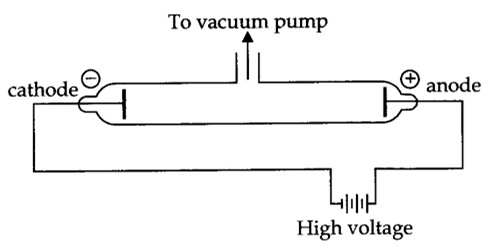CBSE
Class 10 Class 12
The matter is made up of small particles known as atoms. Atom is made of three fundamental particles or sub-atomic particles called electron, proton and neutron.
| Name | Symbol | Mass (g) | Relative Mass | Absolute Charge (C) | Relative Charge |
| Electron | e- | 9 x 10-28 | 1/840 (zero) | -1.6 x 10-14 | -1 |
| Neutron | n | 1.6 x 10-24 | 1 u | 0 | 0 |
| Proton | p+ | 1.6 x 10-24 | 1 u | +1.6 x 10-14 | 1 |
R.A. Millikan performed an experiment in (1906-14) to determine the charge on the electrons. He found that the charge on the electron to be -1.6 x 10-19 C.
The Presently accepted value of electrical charge is -1.6022 x 10-19 C.
The mass of the electron (me) was determined by combining these result with Thomson's value of e/me ratio.
J.J. Thomson measured the ratio of electrical charge (e) to the mass of the electron (me) by using cathode ray tube and applying electrical and magnetic field perpendicular to each other as well as to the path of electrons.
The charge to mass ratio of an electron as e/me =1.758820 x 1011 C kg-1
Where me is the mass of the electron in kg and e is the magnitude of the charge on the electron in coulomb (C).
J.J Thomson in 1897 discovered negatively charged particles known as an electron. He performed an experiment, a gas at low pressure was taken in a glass discharge tube. At the ends of the tube two electrodes were placed, connected to a battery.
The electrode connected to the negative end was knowns as a cathode and that to the positive as anode.
The flow of current from cathode to anode was further checked by making a hole in the anode and coating the tube behind the anode with phosphorescent material zinc sulphide. When these rays, after passing through the anode, strike the zinc sulphide coating, a bright spot on the coating is developed(the same thing happens in a television set).

Output of the Experiment:
Electrical discharge carried out in the modified cathode ray tube led to the discovery of particles carrying a positive charge, also known as canal rays.
The smallest and lightest positive ion was obtained from hydrogen and was called a proton.
This positively charged particle was characterised in 1919.
Characteristics of these positively charged particles:
(i) Cathode rays, the positively charged particles depend upon the nature of gas present in the cathode ray tube.
(ii) The charge to mass ratio of the particles is found to depend on the gas from which these originate.
(iii) Some of the positively charged particles carry a multiple of the fundamental unit of electrical charge.
(iv) The behaviour of these particles in the magnetic or electrical field is opposite to that observed for electron or cathode rays.
In 1932 Chadwick discovered neutral particle known as neutrons by bombarding a thin sheet of beryllium by α-particles.